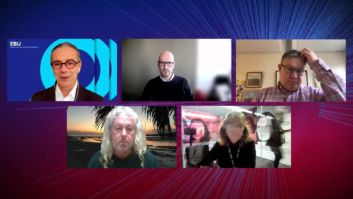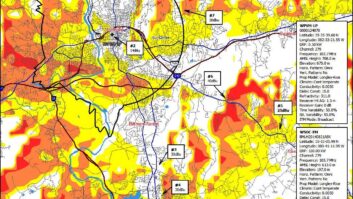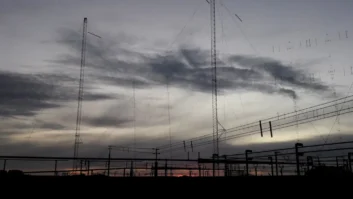Digital Radio Update – August 22, 2007
Aug 22, 2007 11:16 AM, By Mark Krieger, CBT
Stay up to date on the latest IBOC news, business and technology information with the twice-monthly newsletter from Radio magazine.
Index:
- NY Times’ Pogue Reviews Wi-fi Radios
- First HD Radio Tests Launch in Germany
- WFUV Wins Multicast Development Grant
- IBOC by State: Kentucky
- IBOC Rule Changes Kick in on Sept. 14
- HD Radio Adoption Lags…but Why?
- The New Language of HD Radio
- Dice Rolls Out Tabletop HD Radio
To receive these articles twice a month in your e-mail, subscribe to the Digital Radio Update – Insight to IBOC e-newsletter. Click here to subscribe.
News

The Roku Wi-fi radio
NY Times’ Pogue Reviews Wi-fi Radios
In a clear sign that Internet Radio continues its rise in the collective consciousness of U.S. consumers, an August 9 article by New York Times Tech Columnist David Pogue takes a hard look at dedicated Internet radio appliances, with the author seeming to like at least some of what’s currently available.
Among the platforms reviewed were products from Roku, Com One, Revo, Terratec and Tivoli — well known for reviving the fortunes of basic tabletop AM/FM receivers.
Most notable about Pogue’s review is the writer’s enthusiasm for radio as a medium and the sheer pleasure with which he describes the variety of streamed and podcast products now available on the Net.
While all of the appliances sampled exhibited various quirks, the article serves as a benchmark for what will likely become a proliferation of 2nd and 3rd generation products made even more portable by the advent of open-network broadband services.
The complete article can be viewed at: www.nytimes.com.
Technology/Applications
First HD Radio Tests Launch in Germany
Radio Regenbogen, a privately held FM radio outlet located in Germany’s Rhine-Nectar region, says it plans to commence HD Radio transmission tests within a matter of days. The HD Radio operation will include two multicast channels and marks the first IBOC digital radio broadcasting to take place in that nation.
Technical support for the Radio Regenbogen is being provided through a joint effort of Ibiquity Digital, Audioexport Georg Neumann, Orban/CRL Systems, Broadcast Electronics and Ruoss AG, a company that has already assisted with HD Radio tests in Switzerland.
Initial test results will be publicly presented at a regional Government Office for Communication in Stuttgart on Sept. 27, 2007.
Business
WFUV Wins Multicast Development Grant
WFUV, Fordham University’s non-commercial radio station serving the NYC market, has announced the award of a $500,000 grant from the New York State Music Fund. The money is intended to fund development of an eclectic HD multicast format designed to target listeners in the sought after 20-to-30-year-old demographic.
WFUV General Manager Ralph Jennings says the new channel will reflect a diverse blend of indie, electronica, world, dance and other musical forms with a presentation aimed at upscale, educated young people in their 20s and early 30s — a demographic some observers claim has all but abandoned radio. The station plans to develop the service with inputs from artists, labels, writers, websites, bloggers and venues across the city. Programmers will employ an “emerging generation of radio talent for its new air staff, young New Yorkers with a passion for hearing, sharing and discussing music” according to a WFUV press release.
The New York State Music Fund was created when then New York State Attorney General Elliot Spitzer’s office settled multiple cases against major record labels accused of payola. The agreement stipulated that settlement funds received by the state funds be used to support music education and appreciation for the benefit of New York State residents.
WFUV management says the $500,000 grant will cover approximately half of the total development, marketing and rollout costs for the new program stream, which will also be carried on the Web.
IBOC Across America
IBOC by State: Kentucky
Ibiquity has a list of stations with licensed HD Radio technology and notes those on the air now. IBOC by state looks at various states and list the stations making the transition. There are 17 stations in the Bluegrass State broadcasting 19 HD Radio channels.
MarketStationHD-1 FormatHD-2 FormatOwner CorbinWEKF-FM 88.5Clscl/News-Eastern Kentucky University JenkinsWIFX-FM 94.3HotAC/CHR-Gearheart Broadcasting LeroseWOCS-FM 88.3NPR/Varty-Morehead State University Lexington-FayetteWUKY-FM 91.3Variety-University of Kentucky LouisvilleWQMF-FM 95.7Clsc RockAll Live MusicClear Channel Radio LouisvilleWUOL-FM 90.5Classical-Kentucky Public Radio LouisvilleWLRS-FM 105.1New Rock-Radio One LouisvilleWHAS-AM 840News/Talk-Clear Channel Radio LouisvilleWGZB-FM 96.5Urban-Radio One LouisvilleWZKF-FM 98.9CHRHispanic UrbanClear Channel Radio LouisvilleWVEZ-FM 106.9AC-Cox Radio LouisvilleWFPK-FM 91.9AAA-Kentucky Public Radio LouisvilleWFPL-FM 89.3Nws/Tlk/Inf-Kentucky Public Radio MoreheadWMKY-FM 90.3Classical-Morehead State University MurrayWKMS-FM 91.3Variety-Murray State University PaintsvilleWKLW-FM 94.7Hot AC-B&G Broadcasting RadcliffWASE-FM 103.5Oldies-W&B Broadcasting
FCC Update

IBOC Rule Changes Kick in Sept. 14
Publication of the FCC’s Second Report and Order in the Federal Register on Aug. 16 means that the long-awaited IBOC digital radio rule changes will become the law of the land on Sept. 14.
Among the most controversial new provisions will be the green light for 24-hour HD Radio hybrid operation on AM. Critics of Ibiquity’s implementation of AM IBOC digital transmission have charged that many stations currently serving a significant audience within secondary nighttime coverage areas will lose that service area to digitally generated adjacent-channel interference. In a separate but related move announced just this week, the FCC appears to be addressing AM owner coverage anxieties by tendering an NPRM that would grant new FM repeater privileges to eligible AM licensees.
Among other key provisions set to go into effect include the right for FMs to commence HD Radio multicasting without experimental authority grants and use of separate FM antennas for HD Radio hybrid operation without STAs.
Other matters, such as specific public service requirements, limitations on and regulatory fee assessments for digital subscription services, and what role multicasting will play in any new ownership equation remain to be addressed by future rulemaking.
Eye on IBOC
HD Radio Adoption Lags…but Why?
As a number of recent articles in trade literature have pointed out, adoption rates for HD Radio lag behind most research projections, and are a continuing disappointment to broadcast groups that have made substantial financial commitments to digital plant conversion and new programming in an era where operating margins are notoriously tight.
Speculation regarding why this is so abounds. Some blame the ponderous gestation period of the current IBOC standard, others blame new media technology and ubiquitous misappropriation of intellectual property (translation: illegal music downloading). Still others point at the trend towards consumers “pulling” media on a highly individualized basis. Indeed, a litany of explanations indicate that an apparent public indifference to HD Radio can’t be attributed to any single factor.
But as debate about what’s preventing consumers from embracing HD Radio swirls inside industry circles, research trends provide a few theoretically grounded clues about the nature of the problem. Here’s what we know:
Adoption rates are significantly behind prior projections. A recent press release by Bridge Ratings indicates the firm has made a downward adjustment to its predicted trend line on HD Radio adoptions issued just one year ago. And Bridge is not alone. According to an article on e-Marketer.com, Kagen research predicted in 2005 that HD Radio would be generating about 4 percent of radio’s revenue by the end of this year. At this point it’s questionable we’ve even reached the break-even point.
And it’s not a cart before the horse scenario. Station conversion totals are now well into four digits and a large majority of radio listeners have at least a few HD signals available in their markets.
Bridge Ratings highlighted one disturbing finding in their most recent survey that gives a solid clue. Although a higher percentage of consumers report an awareness of HD Radio technology, fewer of them on a percentage basis find the technology compelling enough to warrant a receiver purchase.
For those who have never read Everett Rogers’ Diffusion of Innovations, it may be time for a trip to the library. This impressive work established the now-familiar categories of adopters so widely referenced today. Besides assigning adopter characteristics, Rogers also identifies key innovation attributes that bear directly on the speed of adoption. Leading that list is an attribute described as “relative advantage,” and it’s here that at least one disconnect for consumers seems to be suggested by the research.
Consumers, thus far, do not see multicasting, or “CD-like quality” as compelling reasons to invest significant effort and cash in this new technology. Sure, more channels are good, but why go out of one’s way to get them if you don’t really know what’s on them? Okay, AM HD Radio sounds better…but who really cares if all your listening to is Rush, Sean and Jim Rome?
Another important factor in determining adoption rates and penetration is what Rogers refers to as “Diffusion Networks.” He and others have emphasized the importance of “Opinion Leaders” and other interpersonal connections as pivotal in influencing the adoption decision process.
Consider this: Satellite radio’s penetration, though still lagging behind a number of previous projections, would be nowhere near its current levels had Mel Karmazan not successfully maneuvered Howard Stern into a contract with Sirius. Certainly, Howard’s departure from terrestrial boosted the relative advantage of Sirius Satellite, but Howard is nothing if not a textbook definition of an opinion leader – at least among his millions of fans – and his cheerleading lead many of them to a purchase decision.
Which leaves us to ponder what would happen to HD Radio sales if, say, Rush were suddenly shifted to multicast channels in most major markets, and he talked the move up for months before making it. Or, on a smaller scale, what if the industry began doing the same thing with popular morning shows? What if every prominent local radio personality was charged with convincing their audience that HD Radio is a worthy investment, and they said it like they actually meant it?
If this industry truly believes in an HD Radio advantage, we had best begin communicating it with our audience in a direct, unambiguous and personal way. It’s pretty clear that 30-second promos with clever wordplays, audio special effects and mysterious references to “channels in between” are simply not getting the job done.
If our “opinion leaders” aren’t leading, who will?
Have an opinion of your own? Send it to [email protected].
HD Radio Terminology
The New Language of HD Radio
audio frame: The audio information processed as a unit by the audio encoder, consisting of 2,048 audio samples at a sampling rate of 44.1kHz.
fading: The variation (over time) of the amplitude or relative phase (or both) of one or more frequency components of a received signal, as the result of propagation conditions and/or receiver motion.
main program service (MPS): The main program service replicates the host analog audio program on the digital signal. MPS consists of main program audio and main program service data.
Products
Dice Rolls Out Tabletop HD Radio
Nevada-Based Dice Electronics will attempt to follow up on its early success with car stereo HD adaptors with its new iTR-100, the firm’s first foray into an increasingly competitive tabletop HD Radio market.
The new receiver features HD Radio station-seek, along with exterior antenna jacks designed to allow users to extend their listening range. Auxiliary audio line inputs, dual alarm clock modes, and a total of 20 presets are also standard features, though Dice has chosen to offer the stereo extension speaker only as a system option.












